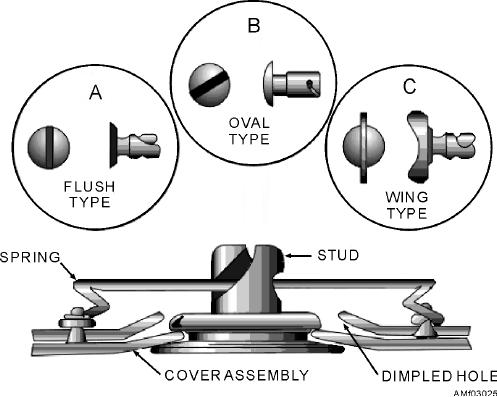
shown in views A, B, and C) and mounts in a dimpled
or cone-shaped washers--the latter being used with
hole in the cover assembly.
flush fasteners in dimpled holes. This fastener may be
distinguished from screws by the deep No. 2 Phillips
When the panel is being positioned on an aircraft,
recess in the stud head and by the bushing in which the
the spring riveted to the structural member enters the
stud is installed.
hollow center of the stud. Then, when the stud is turned
about one-fourth turn, the curved jaws of the stud slip
A threaded insert in the receptacle provides an
over the spring and compress it. The resulting tension
adjustable locking device. As the stud is inserted and
locks the stud in place and secures the panel.
turned counterclockwise one-half turn or more, it
screws out the insert to permit the stud key to engage
Miscellaneous Fasteners
the insert cam when turned clockwise. Rotating the stud
clockwise one-fourth turn engages the insert.
Some fasteners cannot be classified as rivets,
Continued rotation screws the insert in and tightens the
turnlocks, or threaded fasteners. Included in this
fastener. Turning the stud one-fourth turn
category are connectors, couplings, clamps, taper and
counterclockwise will release the stud, but will not
flat-head pins, snap rings, studs, and heli-coil inserts.
screw the insert out far enough to permit
re-engagement. The stud should be turned at least
FLEXIBLE CONNECTORS AND COU-
one-half turn counterclockwise to reset the insert.
PLINGS.--A variety of clamping devices are used in
connecting ducting sections to each other or to various
DZUS FASTNERS.--Dzus fasteners are available
components. Whenever lines, components, or ducting
in two types. A light-duty type is used on box covers,
are disconnected or removed for any reason, you should
access hole covers, and lightweight fairings. The
install suitable plugs, caps, or coverings on the
heavy-duty type is used on cowling and heavy fairings.
openings to prevent the entry of foreign materials. You
The main difference between the two Dzus fasteners is
should also tag the various parts to ensure correct
a grommet, which is only used on the heavy-duty
reinstallation. You should exercise care during
fasteners. Otherwise, their construction features are
handling and installation to ensure that flanges are not
about the same.
scratched, distorted, or deformed. Flange surfaces
Figure 3-25 shows the parts of a light-duty Dzus
should be free of dirt, grease, and corrosion. The
fastener. Notice that they include a spring and a stud.
protective flange caps should be left on the ends of the
The spring is made of cadmium-plated steel music
ducting until the installation progresses to the point
wire, and is usually riveted to an aircraft structural
where removal is necessary.
member. The stud comes in a number of designs (as
Figure 3-25.--Dzus fastener.
3-14

